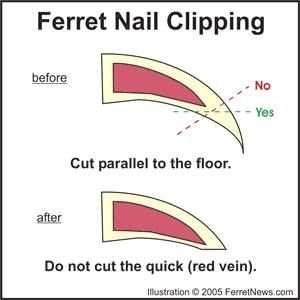Ferrets have sharp, claws that need regular maintenance to keep them healthy and prevent overgrowth. If kept untrimmed, ferrets’ claws can easily become overgrown and cause discomfort or injury to themselves or their owners. Keeping their nails trimmed helps maintain their overall health, prevents pain or injury to themselves or others, and keeps their claws from getting caught on objects and causing injury.
Here’s a step-by-step guide to help you clip your ferret’s nails with confidence.
- Gather the necessary materials: You will need a ferret nail clipper, styptic powder (in case you accidentally cut the quick), and a towel.
Be sure to use nail clippers specifically designed for small animals and ferrets, like these. - Restrain your ferret: Wrap your ferret in a towel, leaving only its paws exposed. This will help keep your ferret calm and still during the clipping process.
- Identify the quick: The “quick” is the pink part in the center of the nail that contains blood vessels and nerves. Be careful not to cut this part, as it can be painful for your ferret and cause bleeding.
- Clip only the tip of the nail: Slowly clip only the tip of the nail, avoiding the “quick.” It’s better to make several small cuts rather than one big cut, which reduces the risk of cutting the “quick.”
- Apply styptic powder: If you accidentally cut the “quick,” quickly apply styptic powder to stop the bleeding. The powder will help to stem the bleeding and soothe any pain.
- Repeat the process: Repeat this process for each nail, making sure to clip only the tips and avoid the “quick.”
- Reward your ferret: After the clipping is finished, reward your ferret with treats and praise to make the experience positive for both of you.

What is Styptic Powder?
Styptic powder is a type of coagulating agent used to stop bleeding from minor cuts or nail trims, typically for animals. It works by constricting blood vessels and promoting blood clotting. Some common ingredients in styptic powder include aluminum sulfate, ferric subsulfate, and calcium sulfate.

 What is a ferret’s “quick?”
What is a ferret’s “quick?”
The “quick” in a ferret’s nail is the pink, fleshy part of the nail that contains nerves and blood vessels. It is located near the base of the nail and is easily visible in light-colored nails. When trimming ferret nails, it’s important to avoid cutting into the “quick,” as it will cause pain and bleeding.

Clipping your ferret’s nails may take some time and patience, but with practice, you and your ferret will both feel more comfortable with the process. Remember to take it slow and be gentle with your furry friend. With these steps in mind, you’ll be a pro at clipping ferret nails in no time!

